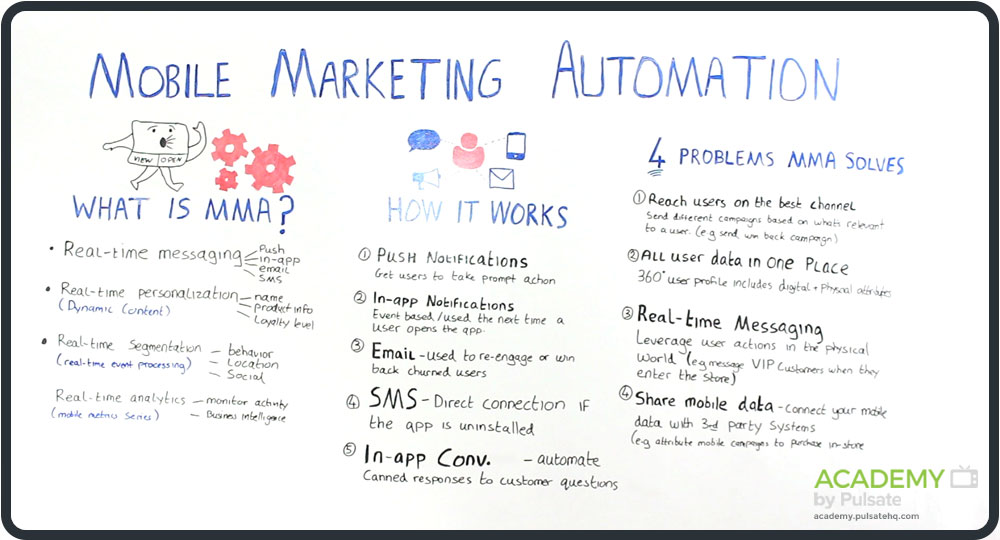In the next few minutes, I’m going to show you everything that you need to know about MMA or mixed martial arts. Just kidding. We are going to be talking today, about mobile marketing automation or MMA, what it is, how you implement it in your business, and what some of the benefits are.

Here’s a still of this week’s Academy whiteboard. Right click and save!
What is Mobile Marketing Automation?
It’s a couple of different things but I’d like to start off by describing it as real-time messaging. It’s the control tower behind your app. It’s the orchestration layer that, while you are eating and sleeping, it’s doing all of the hard work for you.
When there are lots of customers tapping buttons inside your app and are receiving relevant follow on campaigns it’s the automation that is automatically dealing with all of the events.
It’s processing them and it’s deciding what messages to send to each individual customer.
It means you don’t have to be behind the curtain watching everything that’s happening in real-time in your app and sending out messages to each individual user.
Of course, that would be ridiculous. That is what mobile marketing automation does for us. It sits behind the scenes, it’s sending those pushes, it’s sending the in-app messages, the emails and the SMSs, so that we don’t have to.
Real-Time Personalization
It can also do real-time personalization and that could be swapping out the name, it could be swapping out attributes about the customer, it could be personalizing product information. It could also be adjusting based on their loyalty level and certain attributes that that customer holds.
Real-Time Segmentation
We take into account the social data, the location of that customer and the way that they behave in your app which pulls customers into segments in real-time and in the control tower, which is running in the in the background, the orchestration layer of the MMA.
Based on the segments that people join, it’s doing the real-time messaging, sending out the pushes, the emails, the SMSs in real-time. It’s of course, also real-time analytics so you know what’s working and you know what’s not.
It allows you to monitor activity. It’s the BI layer underneath the hood so you know exactly what’s working and what’s not. If you want more information on mobile analytics, I’d suggest you check out the mobile metric series on the Pulsate Academy. It’s pretty cool. We talk about all of the Pirate Metrics from user acquisitionto activation, retention, referral, everything that you need to know. That’s at a high level what MMA is.
How does MMA actually work?
Well, we have the system that’s behind the scenes, that is sending out our in-app messages or emails, our pushes, our SMSs.
First off, we have push notifications.
These are notifications we send out to get users and we prompt them to take action.
Customers could be going through the physical world, they could be walking down the street and they don’t have your app open, they are not staring at your app.
The phone, it may be in their hand, it may be in their pocket but your app is probably not opened. A push notification gets users to take action at the right time and could also be based on geo-data.
An in-app notification is very similar to a push but it doesn’t pop up on the phone. It happens when they are in the app. When the user is already captive, they are already engaged in your experience of using some part of the app, you may want to pop up an in-app notification and say, “Hey, have you seen today’s specials?”
You can use in-app notifications to prompt users to to add their credit card details, or allow push notifications.
Of course, emails can be used to reengage users that have deleted your app. Maybe you want to send people an email automatically after they delete the app and you wanna do an exit survey to find out what was it about your mobile experience that this didn’t work out for that customer, from downloading the app on the store to then using it?
What was that disconnect that caused the uninstall? Maybe you want to try and get them back. Email can be a terrific way of doing this.
Next up, we have SMS and of course SMS is another great way, if the app has been deleted, of getting them back or finding out what caused that delete in the first place.
We can have in-app conversations as well and I’ve said before, this is the year of conversational commerce chat as an interface. Whether it’s with a human or a bot, it doesn’t matter but conversation is the way forward.
You could automate the instantiation of a new conversation so it’s not actually human-initiated. Based on what people are doing, their behaviors, their locations, all of their stuff in the app, their events, you would be starting an in-app conversation.
“This is the year of conversational commerce chat as an interface”
You might reach out and say, “Hey there. We’d like to get your feedback on XYZ feature. We see that you recently visited us. Please, verbally, give us this feedback and reply to the conversation.” But it could be initiated through our mobile marketing automation system.
What are the benefits of using MMA?
1. Reach your app users on the best channel.
The system will calculate whether it’s email, whether it’s in-app, maybe it’s push, maybe it’s SMS. Reach them on the best channel at the best time.
You could send different campaigns based on what’s relevant to the user, based on the platform that they are most receptive to our communication.
2. All of your user data in one place.
We’ve got these 360° profiles of a user in one place. we’ve got the social data, CRM data, the behavioral activity, in-app events, location events etc.
This results in a very complete picture of the user from the CRM standpoint that when we operate on this data from an MMA standpoint, we can make very good decisions and we can automate the best message at the best time using the best channel.
3. Real-time event processing
It means when people show up at locations we see the data in real-time. If they step into that geo-fence, then tap that button in the app, they create that event we can instantly see and send a relevant followup message.
You can add a delay to the notification and leverage all those real-time actions at a later stage.
4. We can share this data.
Smartphones, are the most personal device that we have, our apps send us thousands of signals about who those customers are, rich context, where they show up for us, other apps that they maybe have installed, the times that they use their device and your app and typically, that’s locked up in traditional mobile marketing automation systems.
What we do at Pulsate, and some of the more modern MMA systems, is we take this data and we can webhook or stream it to different systems. If it’s a Twilio, you might want to send an SMS, perhaps you want a webhook into a CRM system such as Salesforce marketing cloud or Adobe marketing cloud to follow on in interactions.
How Pulsate uses Mobile Marketing Automation.
It’s very important that this rich mobile context doesn’t just live in the MMA system. You should be able to take it, transport it and stream it in real-time multi-channel events that all of these other systems can use to create further marketing interactions from.
That’s it for today’s episode on an introduction to mobile marketing automation and everything that you need to know. If you have any questions, as always you can leave a comment below or you can send me a tweet.







HAVE YOUR SAY. LEAVE A COMMENT